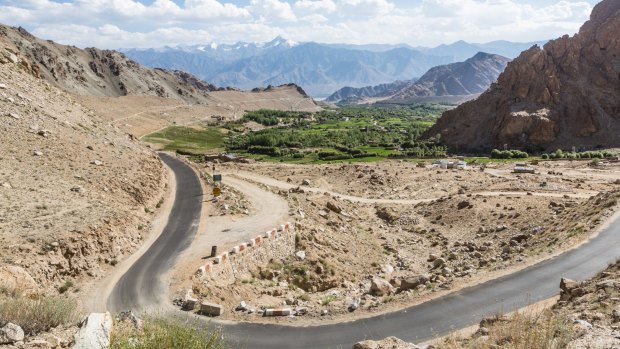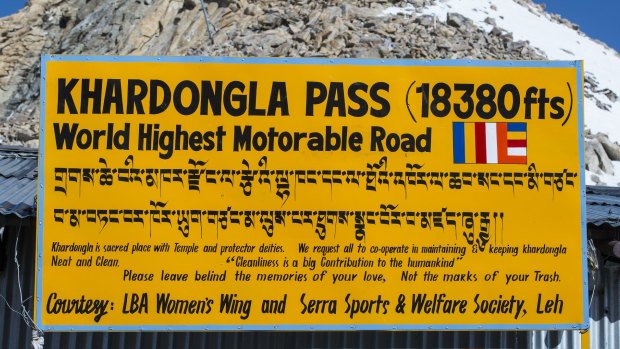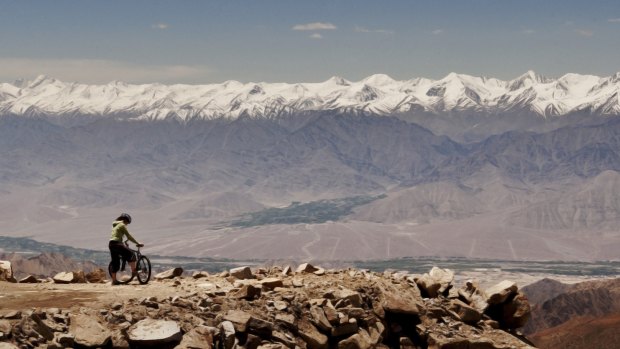This was published 4 years ago
Cycling India's Khardung La Pass: An exhilarating trip down the 'world's highest motorable road'
By Larissa Ham

Tackling the Khardung La Pass on two wheels is a thrill ride.Credit: Getty Images
The sign at the top proclaiming this to be the 'world's highest motorable road' might be a bit of a white lie.
But you know you're ridiculously high when, driving up India's Khardung La Pass, a plane flies by – and instead of craning your head skywards, you realise you're actually looking down.
The adrenaline-loving members of my Intrepid group and I are in the Himalayan region of Ladakh, which, fittingly, translates as the 'land of high passes'.

Khardung La Pass claims to be the world's highest motorable road.Credit: iStock
Having spent the better part of a week trekking and rafting in and around the town of Leh, about 3600 metres above sea level, we've already acclimatised to dizzying heights. But the downhill bike ride that awaits us today, once we've reached the top of this more than 5300 metre-high pass, promises to be next level.
Officially, Khardung La Pass, which connects Leh to India's remote Nubra Valley, is not the world's highest motorable road – apparently there are higher elsewhere in India, Bolivia and Tibet. But why get bogged down in the details?
After a few high-altitude cocktails the night before, things have started off a little shakily on today's early morning adventure. A peek over the barren cliffs, noticeably free of safety barriers, does absolutely nothing to reassure.

Motorcycles and army trucks are a more common sight on the pass than bicycles.Credit: iStock
"Has anyone gone over the edge?" I ask our suspiciously calm guide, Bhupesh. "Not so far, but there's still hope," he replies, deadpan.
One can only pray that the smiling Dalai Lama, looking over us from a picture in the mini bus, is doing his bit to keep us out of harm's way.
After climbing through the mountains for what seems like hours, we reach the snowline, before visibility almost completely disappears at the top.
A nose-holding visit to the nearest toilet, which threatens to overflow, is the first sign that things are about to get a little extreme.
First, it's a quick test of our rental bikes, which, pleasingly, seem to have both suspension and (slightly squeaky) brakes in working order. My bicycle has a name painted on it, Sanjeeb, which endears me to it immediately.
It's freezing and sleeting, so we layer up for the 39 kilometre downhill spin back to Leh. It's like a bunch of kids riding with training wheels for the first time – shaky excitement, mixed with a dash of fear.
It's difficult to see, and the gravel and dirt road in the first long section is bumpy. Snow is melting around us, creating little streams to dodge.
My nervous wrists itch with the effort of braking and holding on to the handlebar grips more tightly than might be recommended. One of my new friends' hands are so frozen she has to double up on her gloves.
But we start to get used to our bikes, the steep cliffs that threaten to our right, and the army trucks making their way up and across the pass. As the visibility improves, a gobsmacking vista – stark mountains as far as the eye can see, interspersed with prayer flags and patches of green in the valley far below - opens up.
Sanjeeb and I start speeding up, but we have no chance keeping up with some of the boy racers in the group, who are charging down the mountain with the gusto of an Indian shopkeeper about to close the first sale of the day.
This pass was historically a vital route connecting Leh to trade routes across Central Asia, with thousands of horses and camels crossing the pass annually. These days, when it's not closed due to snow, it mostly serves the military and travellers.
Aside from army trucks, there's also a constant stream of friendly motorcyclists crossing the pass in pairs on classic Royal Enfield motorcycles – tooting and waving as they pass by. They sing out 'Julley,' (the Ladkhaki word for hello - and bye, please and thank you) as they pass by.
Today it seems we are among very few people mad enough to tackle this mountain-ringed stretch of road on a pushbike. We spot just two other cyclists in a few hours, but unlike us they're plugging their way uphill, mouths set somewhere between a smile and a determined grimace.
Meanwhile, we keep spinning downwards, grinning like maniacs and whooping around hairpin bends for hours. Surely this has got to be one of the most exhilarating rides on the planet.
As always, the photos don't do it justice. But I know this feeling – the sheer excitement and joy of zooming downhill for hours amid the 360-degree beauty of the Himalayas – will stay with me long after my heart rate has returned to normal.
TRIP NOTES
MORE
ladakhtourism.in/Khardungla-Pass.aspx
FLY
GoAir flies from direct from Delhi to Leh. The flight takes around 1 hour and 20 minutes. goair.in Other airlines to fly this route include SpiceJet, Air India and Vistara. Book early.
TOUR
Intrepid will run three of its 11-day tours, India Himalaya: Hike, Bike and Raft in Ladakh, in July, August and September 2020. Prices start from $2650 per adult, in a twin-share room.
Larissa Ham travelled at her own expense.
Sign up for the Traveller Deals newsletter
Get exclusive travel deals delivered straight to your inbox. Sign up now.